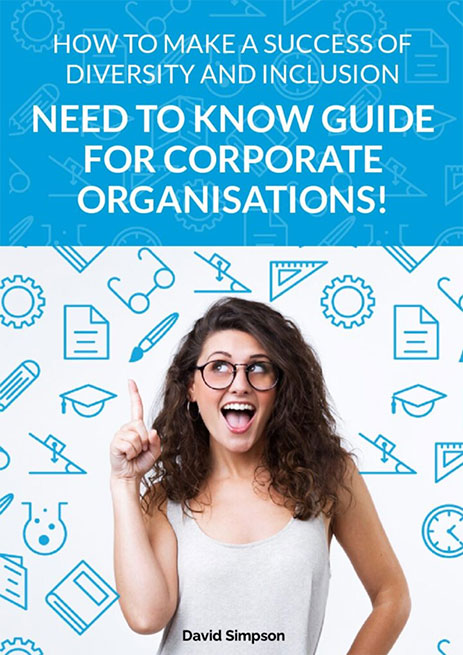In today’s dynamically-changing world where the competition for talent never ends, diversity and inclusion (D&I) have become more critical elements of the strategic plans of many businesses.
Currently, cultural revolutions and changes in workforce demographics are influencing businesses to employ inclusion as a strategy to succeed. The benefits of D&I are enormous, ranging from lowering absenteeism, increasing the ability to attract and retain talent, improving morale and commitment, to fostering innovation and creativity.
Despite often being interlinked, diversity and inclusion are quite different. Diversity is ideally the ‘cake mix’, and inclusion is the intentional effort it takes to make the ‘cake mix’ work.
However, achieving an inclusive environment is somewhat complex, and maintaining a diverse workforce doesn’t guarantee that you will unlock the mix’s full potential.
Existing workplace dynamics demand a move beyond the representation of metrics to engage a more diverse populace. That being said, many employers now face the uphill task of providing ‘inclusively’ conducive and welcoming environments to an ever increasingly diverse pool of talent.
So, how can this be achieved? Here is our list of different effective strategies to apply.
1. Use inclusive language
Employing more inclusive language is one of the subtle small steps an organisation can take.
For example, at one point, most technology companies typically used the word ‘hacker’ for software programmer job descriptions. However, in most cases, only 2% of applicants were female. After exploratory research, they realised that more inclusive language could possibly encourage more women to apply.
Another example is using casual greetings like “hey guys.” While seemingly innocent, this is a male-centric greeting and can be considered non-inclusive.
While it might be hyper-casual language and maybe unimportant, such language is easy to adapt to and might not foster a non-inclusive environment.
Therefore, if you seek to attract more diverse talent, the language used in your job posting can make a significant difference.
2. Appoint inclusive leadership
Inclusive leaders are guardians and protectors of D&I policies. They embrace the input of workers whose backgrounds, ideas or expertise differ from their own.
They also foster collaboration among diverse employees, ask questions of all members, facilitate constructive arguments, deliver actionable feedback, and act upon the advice of their diverse employees.
Furthermore, inclusive leaders can encourage D&I by prizing authenticity over conformity.
Inclusive leadership operates with an understanding that a range of presentation and communication styles can succeed in a workplace. Additionally, with inclusive leadership, a D&I council that helps navigate the D&I policies and challenges employees might face can also be created.

3. Acknowledge different religions and cultural practices
It is important to introduce written policies that honour cultural and religious practices. Such policies can focus on respecting holidays and celebrations.
For example, giving special days off for Christmas, or offering floating holidays to accommodate the religious preferences of employees. This can prove beneficial in improving engagement, employee retention and overall productivity.
4. Celebrate employee differences
Celebrating employee differences is a great way to show a global remote workforce that an organisation values diversity and inclusion. You can do this by honouring the different holidays and celebrations of different countries and cultures, for instance, Diwali and Chinese New Year.
You can also ensure that company holiday celebrations are non-denominational, with non-alcoholic beverages available for those who do not want or cannot drink. A special menu for staff with dietary restrictions is another consideration you can provide.
5. Focus on removing unconscious bias
Multiple research studies strongly suggest that most hiring processes across industries are unfair and full of bias. Unfortunately, humans have implicit biases, an unconscious positive or negative reaction or emotion to something or someone. Much of this bias revolves around unconscious sexism, racism, and ageism.
To combat this and mitigate instances of implicit bias in their processes, companies can consider:
- Setting diversity goals as an organisation to help keep track of your D&I progress.
- Rewriting job descriptions to be gender-neutral and using words that strike a balance of gendered descriptors and verbs.
- Creating a blind system of reviewing resumes, so they are not influenced by “demographic characteristics.”
6. Strengthen anti-discriminatory policies
Many employees find that superficial policies and language are largely insufficient to truly institute real change.
As such, organisations’ leadership commitment to strengthening anti-discriminatory policies is critical. Especially since every organisation is different, tailored approaches are recommended for D&I success.
7. Support innovation and creativity
To achieve a diverse workplace, companies should find ways of continually supporting innovation and creativity within the ranks of organisations. Such policies will allow workers to collaborate outside of achieving the main business goals, thus helping to maintain workplace diversity.
8. Get inclusion feedback on a regular basis within the workplace
Inclusion feedback and accountability help to ensure the success of any organisational initiative, especially diversity initiatives. Accountability is accomplished by ensuring that the appropriate leaders feel responsible for diversity.
You can do this by linking performance evaluation elements and compensation to the successful implementation and progress of these initiatives. Furthermore, accountability ensures that “everyone is on board” and actively engaged in the diversity process.

9. Undertake diversity strategic planning
This focuses on achieving measurable means that diversity can support the strategic direction, goals, and objectives of the organisation.
Until recently, diversity wasn’t seen as an integral part of organisational strategic planning. In practice, diversity initiatives were typically poorly conceptualised, lacked specificity, and weren’t linked to strategic corporate plans.
However, in order to be effective in today’s business landscape, successful diversity planning must support strategic business objectives and operational decisions.
10. Effect diversity management programs
Managing diversity doesn’t necessarily mean controlling or containing it. Neither does it mean assimilating diverse employees to fit into an organisation’s existing culture.
Rather, diversity management focuses on enabling each staff member to perform to their full potential. However, achieving this requires organisations to adopt new ways of thinking about differences amongst staff, as well as new ways in which employees can be treated.
For example, managers need a proactive, committed approach to their involvement with employees. This can be achieved by involving lower managers in the diversity management planning process and giving them ownership of diversity goals.
11. Carry out diversity training
Diversity trainings are workplace diversity management interventions under the umbrella of diversity management. The main purpose of executing diversity training programs is to:
- Promote workplace harmony
- Develop leadership skills
- Assist individuals in learning about the values of others
- Improve cross-cultural communication
- Aid in employee retention

12. Build a mentoring community
You can consider creating a D&I community in your organisation, especially if it has over 100 employees. Every thriving community needs mentors as they can voice concerns and overcome challenges for community members.
For example, PayPal’s Unity program for female employees hosts events to inspire them and make them feel valued.
13. Create an “Open-Door” policy
Managers within organisations should have an open-door policy that encourages
regular feedback to find out what is working and what is not. A safe space to share feedback can help staff to feel free to speak out, with ample opportunity to raise issues related to inclusion.
14. Welcome a multilingual workforce
Working in an environment where almost everyone regularly speaks a language not native to you can be frustrating. This can send a sense of non-inclusiveness to some employees. As such, it is important that organisations take into account the language barriers and preferences of all employees, even those working in different time zones.
For example, if you invite different teams to participate in a virtual event, choose a general language to address them. Or better yet, if you’re a global company, try to offer translation services, so everyone understands what’s being said and feels included.
Generally, employees should feel secure and comfortable communicating in whichever language they find most suitable for them. This is especially so during company-sponsored or sanctioned events.
15. Open a dialogue about gender pay inequality
To achieve a culture of inclusion built on the foundation of trust and transparency, ensure to discuss gender and potential pay disparities. And if possible, even reveal some of the organisation’s data points around compensation.
Despite being a point of contention at many organisations, gender pay equity efforts induce workforce trust and a sense of inclusion. Especially, if a company is transparent about its policies.
For companies that already have gender pay imbalances, it’s imperative to open communication channels so employees can share their feelings and opinions.
Furthermore, ensure to present policies with clarity while addressing the gaps. That way, employees feel safe knowing that the company is committed to taking steps to bridge the gender pay gap.
When confronted, avoid being defensive when presenting the company’s data around such policies. Rather, if data is a bit skewed for a variety of factors (like maternity leave versus untaken paternity leave), comprehensively explain this to employees in a straightforward and clear manner.

Conclusion
Every forward-thinking business leader wants their organisation to be transparent, open, and respectful. In essence, a workplace where employees feel secure, integrated and valued, will help lead to a more successful business.
However, despite some investments in diversity and inclusion initiatives, there is still a disconnect between commitment and results. Nonetheless, the concept of inclusion should not be feared as complicated. People simply wish to be allowed to be themselves instead of feeling isolated.
Arguably, inclusion is somewhat intangible and difficult to measure since it is mostly a feeling. But remember, inclusion is what makes diversity achievable.
Therefore, if you strive to religiously apply the majority of the strategies listed above, you should be able to create a sense of belonging and respect for all. And as a consequence, be on your way to tremendous business success.
The article is a part of our comprehensive series on “Diversity and Inclusion.”

Diversity & Inclusion Training Manual
Learn how virtual reality can build relationships and contribute to the diversity & inclusion needs of your organisation with this free e-book.
Author: David Simpson
Co-founder and Director of Learning and Development David Simpson, originally from Northern Ireland and with a background in psychology, has significantly impacted the learning and development landscape in Asia. In 2002, he co-founded Team Building Asia, one of Asia’s most successful team building companies, and he has been stimulating innovation in corporate training ever since. Co-founder of Growth Academy Asia, David challenges teams to reach their highest potential through experiential, interactive and immersive workshops with a meaningful business outcome.





